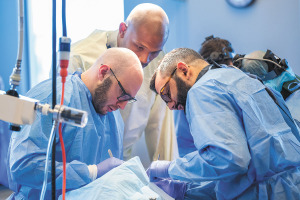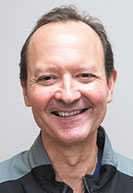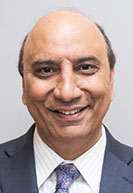Subscriber Benefit
As a subscriber you can listen to articles at work, in the car, or while you work out. Subscribe NowDr. Srikanth Divi picked up a surgical tool that looked like a skinny butter knife, turned to a cadaver on a table and began scraping away muscle tissue from the back of the neck, aiming to expose the bony anatomy.
“Then once we find that, we’re going to practice instruments,” said Divi, a 35-year-old spine surgeon from Chicago. “That means we’re finding the bony corridors where we can place screws.”
His partner at the table, Dr. James Rizkalla from Dallas, took a turn scraping and began thinking of other techniques.
“We can also use a hot knife that coagulates and allows you to burn tissue,” explained Rizkalla, 32. “It’s a good way to clean and identify that bony anatomy as well.”
The doctors were among more than 30 young cervical spine surgeons from around the country who were practicing various procedures on cadavers laid out on about a dozen tables. The goal was to learn more about techniques in surgery, from navigating the cervical spine to using highly sophisticated equipment to handle potential complications from major operations.
The three-day course, organized by the Cervical Spine Research Society based in Milwaukee, took place last month on the Carmel campus of Indiana Spine Group, a small, 22-year-old practice with about two dozen physicians.
While these types of training events are often held in major academic centers in large cities, the Indiana Spine Group is gaining a reputation as a training and education center. It holds courses for high school and college students in anatomy as well as surgeons going out on their own after residencies and fellowships.
Denise Lemke, executive director of the Cervical Spine Research Society, said Indiana Spine Group’s laboratory, auditorium and conference rooms are ideal for young surgeons to learn and perfect their techniques.
“It’s really an opportunity for them to practice the skills in the lab with no consequences,” she said. “They don’t have to worry if they nick an artery in practice. In surgery, it could kill someone.”


Some senior surgeons say the Carmel practice has a laboratory layout that rivals some medical schools, with a wide array of tools, X-ray equipment, surgical microscopes and navigation technology that allows surgeons to precisely track instrument positions using imaging data.
“This is a first-class facility that basically replicates an operating room that you have at your home [hospital], which allows you to go to the next level of training under controlled environments,” said Dr. Mike Daubs, professor and chair of the department of orthopedics at the University of Nevada Las Vegas’ School of Medicine, as he took a break from the lectures and lab procedures.
 Curtis Cooper, a consultant for Atlas Spine, a Florida company that make spinal implants and surgical instruments, called Indiana Spine Group’s laboratory one of the best he has seen in visits all over the country. “This is a world-class facility that offers the highest level of equipment and latest technology,” he said.
Curtis Cooper, a consultant for Atlas Spine, a Florida company that make spinal implants and surgical instruments, called Indiana Spine Group’s laboratory one of the best he has seen in visits all over the country. “This is a world-class facility that offers the highest level of equipment and latest technology,” he said.

Dr. Michael McCarthy, a spine surgeon who trained in Chicago and New York, said when he interviewed at Indiana Spine Group about five years ago, he was flabbergasted by the size of the training laboratory.
“I trained at Northwestern, and we had something that was half the footprint of this,” he said. “This is why I joined the group—because I knew that education is our focus. We’re a private practice group focused on training the next surgeons in the United States.”
Growing need
Across the country, spine surgery is becoming a critical field, as millions of people suffer from neck and back pain that can hurt their ability to work, play and even relax without painful compressions on their spine.
And as people age, the spinal discs in the back and neck can dry out and no longer cushion the bones. That can exert extra pressure on the spine and cause pain.
“These are degenerative problems that happen as we age,” Daubs said. “And the issues that we deal with here are very common because the boomer generation is aging quickly.”
Many senior surgeons attending the April workshop as presenters or faculty members said they normally handle six to 12 operations a week, depending on the complexity of the case. The faculty last month included surgeons from New York City, Philadelphia, Seattle, Atlanta and other cities.
And the junior surgeons said they welcome the opportunity to upgrade their surgical techniques.
 “Working here in the cadaver lab, we can do things we can’t do with patients in the operating room,” said Dr. Jessica Albanese, 32, of Syracuse, New York. “This gives me a chance to work on my surgical skills to become better, safer, more efficient.”
“Working here in the cadaver lab, we can do things we can’t do with patients in the operating room,” said Dr. Jessica Albanese, 32, of Syracuse, New York. “This gives me a chance to work on my surgical skills to become better, safer, more efficient.”
At a nearby table, Dr. Philip Louie, a spine surgeon from Seattle, was training four young surgeons on how to remove part of the spine to get a better look at the spinal cord. Sometimes serious arthritis or a tumor is pushing against the spinal cord, and surgeons need to learn how to take pressure off the cord, he said.
And how were the young surgeons doing?
“So far, so good,” Louie said. “They got the exposure done. We got our light and retractors set up. Now they’re starting to use real tools.”
The lab includes microscopes with cameras, allowing students to watch from the nearby auditorium on a livestream as the surgeon at the table explains her technique in real time.
In the auditorium, surgeons crowded into chairs to hear dozens of highly technical medical presentations. (Example: “Subaxial fixation: When and why to place cervical pedicle screws.”)
Just a few dozen paces away is the group’s Indiana Spine Hospital, with three operating rooms and 20 beds. The campus also includes a medical office building.

Dr. Rick Sasso, co-founder and president of Indiana Spine Group, said the three-story training center, which the group calls an academic medical center, cost millions of dollars to build. Sasso is also chief of spine surgery at the Indiana University School of Medicine.
“I wanted a learning center where we could differentiate ourselves from every other group,” he said. “If you look at all the equipment we have here, it’s like having 10 operating rooms.”
Hardy Sikand, the group’s CEO, said the medical academic center doesn’t pay for itself but is worth the expense because of its training and educational features. The practice built the medical academic center 14 years ago.
“It’s not revenue generating,” he said. “It’s actually a cost center. So over time, it’s been millions of dollars” to build and operate.
Other options

Across central Indiana, large hospitals and medical practices also have training and education sessions for medical students and physicians.
Goodman Campbell Brain and Spine, also based in Carmel, recently teamed up with Ascension St. Vincent, where it will handle cases in a four-story brain and spine hospital under construction on the West 86th Street campus in Indianapolis. The hospital, set to open next year, will have eight operating rooms, 36 intensive-care-unit beds and a dedicated “stepdown unit” for recovering patients.
Goodman Campbell said it has a long history of educating and training undergraduates, medical students and young medical professionals. This month, it will host its annual NeuroCon, a daylong conference to introduce medical professionals to surgeries and procedures.
In addition, it works with Marian University to provide third- and fourth-year clinical rotations in neurosurgery. It also offers a two-year endovascular fellowship to train neurosurgeons, neurologists and radiologists.

Several of its physicians are adjunct professors at Purdue University’s Weldon School of Biomedical Engineering.
“All of these endeavors also play a critical role in attracting physicians from around the country to relocate to central Indiana for their career in medicine,” Derek Cantrell, CEO of Goodman Campbell, wrote in an email to IBJ. “Most importantly, they lead to better patient care. It is built into our daily mission.”
Indiana Spine Group said it isn’t necessarily competing with other practices; it is just trying to offer the best training and education facilities it can.
“What they’ve built here is world-class, it really is,” said Daubs, the Las Vegas surgeon. “And here in Indiana.”•
Please enable JavaScript to view this content.

Dr. Rick Sasso performed my spine surgery in 1993 and it was very successful. Congrats, Doc!
Exceptional training facility, have used it many times to train orthopaedic surgeons, and one of the nicest views while working on education with all the windows…